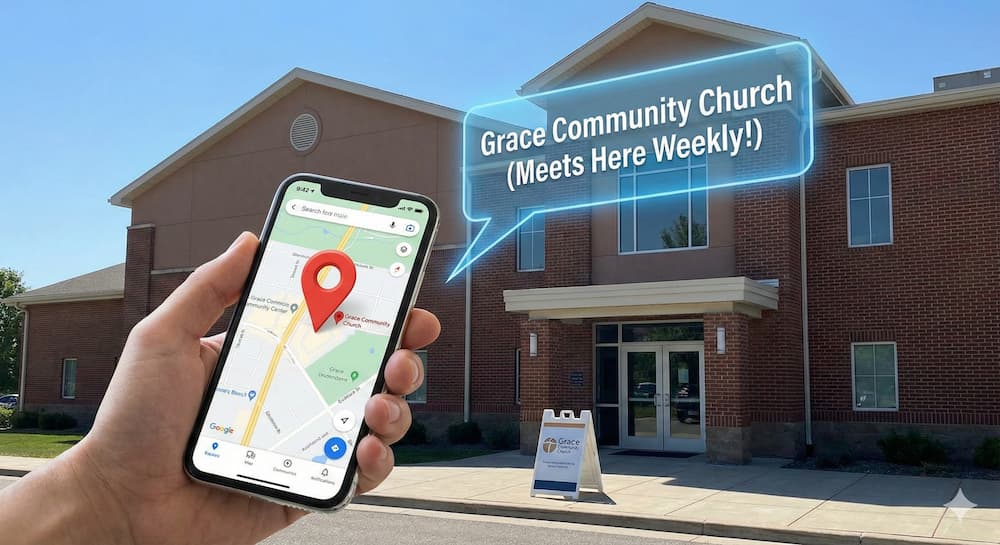How to Craft a High-ROI Church Welcome Images (with Practical Examples)
Transform your church welcome images from place-holders to growth-boosters with these 7 best practices.

Church welcome images don’t seem like a deep aspect of church.
We often delegate the church welcome images to the 14-year-old with the growing Instagram account or the youth pastor.
But church welcome images are more than an aesthetic emblem we use to stylize our churches.
They actually say something.
And the thoughtfulness that we do (or don’t) put into church welcome messages can be the very make-or-break soft messaging that prompts newcomers to return for a second visit or compels them to try out alternative church options.
In this article, we will break down seven practices that can help you craft the perfect church welcome image, as well as seven welcome images that are clearly the product of these practices.
Church Welcome Images: Best Practices
These seven practices have been tested and proven to boost engagement in churches.
Implement these principles if you want to boost newcomer sign-ups, member engagement, and retention of welcome-relevant information.
1. Send a message
Make sure that your welcome message communicates something in particular.
Obviously “Welcome!” is the obvious choice for what to communicate with a “Welcome Image,” but it’s much more effective if you take this one step further.
What sense do you want people to have when they walk into your sanctuary and see the welcome image on the screen?
Do you want them to feel comforted, at home, excited, informed, or helped?
Most pastors will say: All those things!
That’s great.
But you can’t communicate every positive emotion in a single image.
Create a welcome image strategy that allows you to hone down your welcome image message for each service.
Ask yourself and your communications team some key diagnostic questions:
- What are we preaching on?
- What is the call to action?
- Are there any immediate events for which we want people to register?
- Which pastor is preaching?
- What will be the worship songs?
2. Ask your youth group if it’s tacky
Youth are often more plugged in to what will attract adults than the adults on church staff.
Chalk it up to youthfulness, media consumption, or just plain adults becoming out of touch, youth very often have an eye for aesthetics and messaging that could serve as a simple litmus test for whether your welcome images cross a line into “trying too hard,” “too tacky,” or “way too outdated.”
This doesn’t mean you have to let your youth run your communications team.
But it’s worth getting their two cents if it means getting a higher retention rate for your newcomers.
3. Discover what works well for other churches
If there’s a successful church in your area with amazing design, find their communications pastor online and ask him for advice about creating your own church welcome images.
Most growing churches are happy to network with other churches, share ideas, and collaborate to create a culture of excellence among churches in the area.
4. Use extremely readable font
There is something to be said for “script” font—that is, digital font that looks like it was handwritten.
There is also something to be said for odd variations with exaggerated serifs, overt blockiness, and modern thin letter stems.
However, it’s important to remember that welcome images aren’t an art contest—their primary function is readability, and their secondary function is messaging.
If your visitors and members need to squint to understand your welcome image, it needs to be revised.
5. Direct people to your website
You should direct people to your website on your welcome image.
Sometimes, a website can distract from a time-sensitive or seasonal message. But most often, people appreciate being guided to more information.
There is a reason that people show up to church—and it’s that they want to be connected. You can make this easy by including a URL in readable, contrasted font in a way that blends well with the overall design of the image. Just make sure that the URL doesn’t distract from the primary message of the image, unless the primary message is: “Visit our website!”
This is a bold message, and could work on the right occasion, but shouldn’t be your message every Sunday, as it will exhaust people with self-referential messaging. People want to be encouraged, uplifted, and invited, and in a world full of “clickable” ads, web-oriented messaging can feel a bit like the exhausting advertising that exists everywhere outside the church.
6. Give people a call to action
There should be some call to action in your welcome image.
People often show up early to church, and in their few minutes before the service, they may find themselves with idle hands.
If this is the case, their eyes will naturally drift toward the welcome image, in which case a call to action of some kind—whether it is something in the bulletin, on your website, or during the service—will be appreciated so that they can better follow along with the service.
7. Gather as much visitor data as you possibly can
Again, not every welcome image can do this—but this works especially well if you have a rotating welcome image.
Make sure that if you have new visitors, they can’t enter and exit your church without being asked for their information several times.
Some people are more private, and prefer not to give their information. This is perfectly fine, and they most likely won’t be offended that you’ve asked for their personal information (they’re used to it).
The best way to capture visitor information is to have multiple opportunities to enter the same information.
- Have iPads out front displaying a “Visitor” kiosk page at your church.
- Have high quality, cardstock paper cards at each seat for visitors to fill out.
- Put a URL on the welcome images that reads: “New visitors: Connect with us here! [LINK]”
Church Welcome Image Examples
Enough strategy.
It’s time to take a look at real-life church welcome image examples.
Each of these examples represents a different genre of welcome image (from Creationswap).
Use them as inspiration for your own church’s welcome image strategy.
1. Generic Church Welcome Image

2. Celebratory Holiday

3. Text-to-Give

4. Expression of Gratitude

5. Special Church Event

6. Message-Specific Holiday

7. Acknowledgement of Effort

Over to you
If you think deeply about your church’s welcome image strategy, you will quickly see the return on investment in the form of newcomer and current member engagement.
People like to prepare their hearts for worship before church.
Your welcome image can be an aid for them to do this more deeply by connecting them to the local church.
Most people in church are exhausted from their work week and are taking the only 5 minutes they have throughout the whole week to think about church.
Your church welcome image strategy can make that 5-minutes highly efficient and effective.
Sign Up for Product Updates
Church welcome images don’t seem like a deep aspect of church.
We often delegate the church welcome images to the 14-year-old with the growing Instagram account or the youth pastor.
But church welcome images are more than an aesthetic emblem we use to stylize our churches.
They actually say something.
And the thoughtfulness that we do (or don’t) put into church welcome messages can be the very make-or-break soft messaging that prompts newcomers to return for a second visit or compels them to try out alternative church options.
In this article, we will break down seven practices that can help you craft the perfect church welcome image, as well as seven welcome images that are clearly the product of these practices.
Church Welcome Images: Best Practices
These seven practices have been tested and proven to boost engagement in churches.
Implement these principles if you want to boost newcomer sign-ups, member engagement, and retention of welcome-relevant information.
1. Send a message
Make sure that your welcome message communicates something in particular.
Obviously “Welcome!” is the obvious choice for what to communicate with a “Welcome Image,” but it’s much more effective if you take this one step further.
What sense do you want people to have when they walk into your sanctuary and see the welcome image on the screen?
Do you want them to feel comforted, at home, excited, informed, or helped?
Most pastors will say: All those things!
That’s great.
But you can’t communicate every positive emotion in a single image.
Create a welcome image strategy that allows you to hone down your welcome image message for each service.
Ask yourself and your communications team some key diagnostic questions:
- What are we preaching on?
- What is the call to action?
- Are there any immediate events for which we want people to register?
- Which pastor is preaching?
- What will be the worship songs?
2. Ask your youth group if it’s tacky
Youth are often more plugged in to what will attract adults than the adults on church staff.
Chalk it up to youthfulness, media consumption, or just plain adults becoming out of touch, youth very often have an eye for aesthetics and messaging that could serve as a simple litmus test for whether your welcome images cross a line into “trying too hard,” “too tacky,” or “way too outdated.”
This doesn’t mean you have to let your youth run your communications team.
But it’s worth getting their two cents if it means getting a higher retention rate for your newcomers.
3. Discover what works well for other churches
If there’s a successful church in your area with amazing design, find their communications pastor online and ask him for advice about creating your own church welcome images.
Most growing churches are happy to network with other churches, share ideas, and collaborate to create a culture of excellence among churches in the area.
4. Use extremely readable font
There is something to be said for “script” font—that is, digital font that looks like it was handwritten.
There is also something to be said for odd variations with exaggerated serifs, overt blockiness, and modern thin letter stems.
However, it’s important to remember that welcome images aren’t an art contest—their primary function is readability, and their secondary function is messaging.
If your visitors and members need to squint to understand your welcome image, it needs to be revised.
5. Direct people to your website
You should direct people to your website on your welcome image.
Sometimes, a website can distract from a time-sensitive or seasonal message. But most often, people appreciate being guided to more information.
There is a reason that people show up to church—and it’s that they want to be connected. You can make this easy by including a URL in readable, contrasted font in a way that blends well with the overall design of the image. Just make sure that the URL doesn’t distract from the primary message of the image, unless the primary message is: “Visit our website!”
This is a bold message, and could work on the right occasion, but shouldn’t be your message every Sunday, as it will exhaust people with self-referential messaging. People want to be encouraged, uplifted, and invited, and in a world full of “clickable” ads, web-oriented messaging can feel a bit like the exhausting advertising that exists everywhere outside the church.
6. Give people a call to action
There should be some call to action in your welcome image.
People often show up early to church, and in their few minutes before the service, they may find themselves with idle hands.
If this is the case, their eyes will naturally drift toward the welcome image, in which case a call to action of some kind—whether it is something in the bulletin, on your website, or during the service—will be appreciated so that they can better follow along with the service.
7. Gather as much visitor data as you possibly can
Again, not every welcome image can do this—but this works especially well if you have a rotating welcome image.
Make sure that if you have new visitors, they can’t enter and exit your church without being asked for their information several times.
Some people are more private, and prefer not to give their information. This is perfectly fine, and they most likely won’t be offended that you’ve asked for their personal information (they’re used to it).
The best way to capture visitor information is to have multiple opportunities to enter the same information.
- Have iPads out front displaying a “Visitor” kiosk page at your church.
- Have high quality, cardstock paper cards at each seat for visitors to fill out.
- Put a URL on the welcome images that reads: “New visitors: Connect with us here! [LINK]”
Church Welcome Image Examples
Enough strategy.
It’s time to take a look at real-life church welcome image examples.
Each of these examples represents a different genre of welcome image (from Creationswap).
Use them as inspiration for your own church’s welcome image strategy.
1. Generic Church Welcome Image

2. Celebratory Holiday

3. Text-to-Give

4. Expression of Gratitude

5. Special Church Event

6. Message-Specific Holiday

7. Acknowledgement of Effort

Over to you
If you think deeply about your church’s welcome image strategy, you will quickly see the return on investment in the form of newcomer and current member engagement.
People like to prepare their hearts for worship before church.
Your welcome image can be an aid for them to do this more deeply by connecting them to the local church.
Most people in church are exhausted from their work week and are taking the only 5 minutes they have throughout the whole week to think about church.
Your church welcome image strategy can make that 5-minutes highly efficient and effective.
podcast transcript
Church welcome images don’t seem like a deep aspect of church.
We often delegate the church welcome images to the 14-year-old with the growing Instagram account or the youth pastor.
But church welcome images are more than an aesthetic emblem we use to stylize our churches.
They actually say something.
And the thoughtfulness that we do (or don’t) put into church welcome messages can be the very make-or-break soft messaging that prompts newcomers to return for a second visit or compels them to try out alternative church options.
In this article, we will break down seven practices that can help you craft the perfect church welcome image, as well as seven welcome images that are clearly the product of these practices.
Church Welcome Images: Best Practices
These seven practices have been tested and proven to boost engagement in churches.
Implement these principles if you want to boost newcomer sign-ups, member engagement, and retention of welcome-relevant information.
1. Send a message
Make sure that your welcome message communicates something in particular.
Obviously “Welcome!” is the obvious choice for what to communicate with a “Welcome Image,” but it’s much more effective if you take this one step further.
What sense do you want people to have when they walk into your sanctuary and see the welcome image on the screen?
Do you want them to feel comforted, at home, excited, informed, or helped?
Most pastors will say: All those things!
That’s great.
But you can’t communicate every positive emotion in a single image.
Create a welcome image strategy that allows you to hone down your welcome image message for each service.
Ask yourself and your communications team some key diagnostic questions:
- What are we preaching on?
- What is the call to action?
- Are there any immediate events for which we want people to register?
- Which pastor is preaching?
- What will be the worship songs?
2. Ask your youth group if it’s tacky
Youth are often more plugged in to what will attract adults than the adults on church staff.
Chalk it up to youthfulness, media consumption, or just plain adults becoming out of touch, youth very often have an eye for aesthetics and messaging that could serve as a simple litmus test for whether your welcome images cross a line into “trying too hard,” “too tacky,” or “way too outdated.”
This doesn’t mean you have to let your youth run your communications team.
But it’s worth getting their two cents if it means getting a higher retention rate for your newcomers.
3. Discover what works well for other churches
If there’s a successful church in your area with amazing design, find their communications pastor online and ask him for advice about creating your own church welcome images.
Most growing churches are happy to network with other churches, share ideas, and collaborate to create a culture of excellence among churches in the area.
4. Use extremely readable font
There is something to be said for “script” font—that is, digital font that looks like it was handwritten.
There is also something to be said for odd variations with exaggerated serifs, overt blockiness, and modern thin letter stems.
However, it’s important to remember that welcome images aren’t an art contest—their primary function is readability, and their secondary function is messaging.
If your visitors and members need to squint to understand your welcome image, it needs to be revised.
5. Direct people to your website
You should direct people to your website on your welcome image.
Sometimes, a website can distract from a time-sensitive or seasonal message. But most often, people appreciate being guided to more information.
There is a reason that people show up to church—and it’s that they want to be connected. You can make this easy by including a URL in readable, contrasted font in a way that blends well with the overall design of the image. Just make sure that the URL doesn’t distract from the primary message of the image, unless the primary message is: “Visit our website!”
This is a bold message, and could work on the right occasion, but shouldn’t be your message every Sunday, as it will exhaust people with self-referential messaging. People want to be encouraged, uplifted, and invited, and in a world full of “clickable” ads, web-oriented messaging can feel a bit like the exhausting advertising that exists everywhere outside the church.
6. Give people a call to action
There should be some call to action in your welcome image.
People often show up early to church, and in their few minutes before the service, they may find themselves with idle hands.
If this is the case, their eyes will naturally drift toward the welcome image, in which case a call to action of some kind—whether it is something in the bulletin, on your website, or during the service—will be appreciated so that they can better follow along with the service.
7. Gather as much visitor data as you possibly can
Again, not every welcome image can do this—but this works especially well if you have a rotating welcome image.
Make sure that if you have new visitors, they can’t enter and exit your church without being asked for their information several times.
Some people are more private, and prefer not to give their information. This is perfectly fine, and they most likely won’t be offended that you’ve asked for their personal information (they’re used to it).
The best way to capture visitor information is to have multiple opportunities to enter the same information.
- Have iPads out front displaying a “Visitor” kiosk page at your church.
- Have high quality, cardstock paper cards at each seat for visitors to fill out.
- Put a URL on the welcome images that reads: “New visitors: Connect with us here! [LINK]”
Church Welcome Image Examples
Enough strategy.
It’s time to take a look at real-life church welcome image examples.
Each of these examples represents a different genre of welcome image (from Creationswap).
Use them as inspiration for your own church’s welcome image strategy.
1. Generic Church Welcome Image

2. Celebratory Holiday

3. Text-to-Give

4. Expression of Gratitude

5. Special Church Event

6. Message-Specific Holiday

7. Acknowledgement of Effort

Over to you
If you think deeply about your church’s welcome image strategy, you will quickly see the return on investment in the form of newcomer and current member engagement.
People like to prepare their hearts for worship before church.
Your welcome image can be an aid for them to do this more deeply by connecting them to the local church.
Most people in church are exhausted from their work week and are taking the only 5 minutes they have throughout the whole week to think about church.
Your church welcome image strategy can make that 5-minutes highly efficient and effective.
VIDEO transcript
Church welcome images don’t seem like a deep aspect of church.
We often delegate the church welcome images to the 14-year-old with the growing Instagram account or the youth pastor.
But church welcome images are more than an aesthetic emblem we use to stylize our churches.
They actually say something.
And the thoughtfulness that we do (or don’t) put into church welcome messages can be the very make-or-break soft messaging that prompts newcomers to return for a second visit or compels them to try out alternative church options.
In this article, we will break down seven practices that can help you craft the perfect church welcome image, as well as seven welcome images that are clearly the product of these practices.
Church Welcome Images: Best Practices
These seven practices have been tested and proven to boost engagement in churches.
Implement these principles if you want to boost newcomer sign-ups, member engagement, and retention of welcome-relevant information.
1. Send a message
Make sure that your welcome message communicates something in particular.
Obviously “Welcome!” is the obvious choice for what to communicate with a “Welcome Image,” but it’s much more effective if you take this one step further.
What sense do you want people to have when they walk into your sanctuary and see the welcome image on the screen?
Do you want them to feel comforted, at home, excited, informed, or helped?
Most pastors will say: All those things!
That’s great.
But you can’t communicate every positive emotion in a single image.
Create a welcome image strategy that allows you to hone down your welcome image message for each service.
Ask yourself and your communications team some key diagnostic questions:
- What are we preaching on?
- What is the call to action?
- Are there any immediate events for which we want people to register?
- Which pastor is preaching?
- What will be the worship songs?
2. Ask your youth group if it’s tacky
Youth are often more plugged in to what will attract adults than the adults on church staff.
Chalk it up to youthfulness, media consumption, or just plain adults becoming out of touch, youth very often have an eye for aesthetics and messaging that could serve as a simple litmus test for whether your welcome images cross a line into “trying too hard,” “too tacky,” or “way too outdated.”
This doesn’t mean you have to let your youth run your communications team.
But it’s worth getting their two cents if it means getting a higher retention rate for your newcomers.
3. Discover what works well for other churches
If there’s a successful church in your area with amazing design, find their communications pastor online and ask him for advice about creating your own church welcome images.
Most growing churches are happy to network with other churches, share ideas, and collaborate to create a culture of excellence among churches in the area.
4. Use extremely readable font
There is something to be said for “script” font—that is, digital font that looks like it was handwritten.
There is also something to be said for odd variations with exaggerated serifs, overt blockiness, and modern thin letter stems.
However, it’s important to remember that welcome images aren’t an art contest—their primary function is readability, and their secondary function is messaging.
If your visitors and members need to squint to understand your welcome image, it needs to be revised.
5. Direct people to your website
You should direct people to your website on your welcome image.
Sometimes, a website can distract from a time-sensitive or seasonal message. But most often, people appreciate being guided to more information.
There is a reason that people show up to church—and it’s that they want to be connected. You can make this easy by including a URL in readable, contrasted font in a way that blends well with the overall design of the image. Just make sure that the URL doesn’t distract from the primary message of the image, unless the primary message is: “Visit our website!”
This is a bold message, and could work on the right occasion, but shouldn’t be your message every Sunday, as it will exhaust people with self-referential messaging. People want to be encouraged, uplifted, and invited, and in a world full of “clickable” ads, web-oriented messaging can feel a bit like the exhausting advertising that exists everywhere outside the church.
6. Give people a call to action
There should be some call to action in your welcome image.
People often show up early to church, and in their few minutes before the service, they may find themselves with idle hands.
If this is the case, their eyes will naturally drift toward the welcome image, in which case a call to action of some kind—whether it is something in the bulletin, on your website, or during the service—will be appreciated so that they can better follow along with the service.
7. Gather as much visitor data as you possibly can
Again, not every welcome image can do this—but this works especially well if you have a rotating welcome image.
Make sure that if you have new visitors, they can’t enter and exit your church without being asked for their information several times.
Some people are more private, and prefer not to give their information. This is perfectly fine, and they most likely won’t be offended that you’ve asked for their personal information (they’re used to it).
The best way to capture visitor information is to have multiple opportunities to enter the same information.
- Have iPads out front displaying a “Visitor” kiosk page at your church.
- Have high quality, cardstock paper cards at each seat for visitors to fill out.
- Put a URL on the welcome images that reads: “New visitors: Connect with us here! [LINK]”
Church Welcome Image Examples
Enough strategy.
It’s time to take a look at real-life church welcome image examples.
Each of these examples represents a different genre of welcome image (from Creationswap).
Use them as inspiration for your own church’s welcome image strategy.
1. Generic Church Welcome Image

2. Celebratory Holiday

3. Text-to-Give

4. Expression of Gratitude

5. Special Church Event

6. Message-Specific Holiday

7. Acknowledgement of Effort

Over to you
If you think deeply about your church’s welcome image strategy, you will quickly see the return on investment in the form of newcomer and current member engagement.
People like to prepare their hearts for worship before church.
Your welcome image can be an aid for them to do this more deeply by connecting them to the local church.
Most people in church are exhausted from their work week and are taking the only 5 minutes they have throughout the whole week to think about church.
Your church welcome image strategy can make that 5-minutes highly efficient and effective.


















.jpg)









